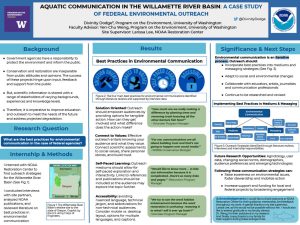Aquatic Communication in the Willamette River Basin: A Case Study on Federal Environmental Outreach
Government agencies have a responsibility to protect the environment and inform the public, sharing scientific information with a broad range of stakeholders. Particularly, aquatic ecosystem knowledge among the public is limited, research remains underutilized and restoration is underfunded. The aim of the study was to uncover best practices in environmental communication that federal agencies may implement to overcome barriers that inhibit restoration action and inform the wide audiences that agencies serve. I conducted semi-formal phone interviews with NOAA Restoration Center’s partners in the Willamette River Basin. Non-profits, state agencies, and federal agencies were interviewed to discuss gaps in knowledge, environmental values, and preferred communication mediums. Following the thematic coding of interview data, responses were cross-compared with the broader literature on environmental communication. I then analyzed NOAA’s existing publications on the Willamette River Basin to make specific recommendations for stronger future outreach. Best practices identified include utilizing a diverse array of mediums that are sharable and allow for self-paced exploration. Additionally, outreach should connect scientific assessments to social values, minimize technical jargon, and be action-oriented while including tangible measures for the audience to take. Improving environmental communications, particularly for aquatic ecosystems, is central to addressing increasing environmental degradation. Education and outreach increase funding, attention, and restoration in degraded areas, thereby improving human and ecological health near these sites. Utilizing these communication strategies improves government and public relations while allowing a diverse array of communities to enjoy restored, resilient ecosystems.
